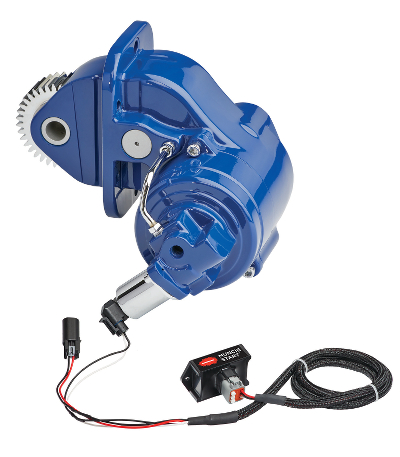The Start of Something – Muncie Start
Featured in Muncie Power Quarterly, Issue 3, 2018
Updated September 1, 2021
 There have been several new product releases coming from Muncie Power Products lately, and one of the most exciting is the Muncie Start® system. Judging by the name, it is the start of something—but what? Allow me to explain.
There have been several new product releases coming from Muncie Power Products lately, and one of the most exciting is the Muncie Start® system. Judging by the name, it is the start of something—but what? Allow me to explain.
Think back to the early days of learning how to drive a car with a manual transmission. On level ground, the process of taking off from a stop was fairly straightforward—put the car in gear, release the brake, let off the clutch, and voilà! The car started moving!
If that same car was pointed up a steep hill, however, things were a bit harder. That took a more refined technique. The clutch needed to be let out gradually to prevent the engine from stalling, yet fast enough the car did not start to roll backward. If the clutch were released abruptly, the mass of the car combined with the hill meant that the inertia was too much for the engine to overcome. “Dumping” the clutch resulted in a sudden jolt of the vehicle, the engine dying immediately, and whatever traffic was left stuck behind the now stalled vehicle feeling extra friendly.
In the world of clutch-shifted power take-offs (PTOs), a typical hydraulic pump application is akin to the car on level ground; there is not much need to ease the clutch into engagement. But for an application with high inertia—such as a blower or generator—the PTO is just like the car on a steep hill.
Clutch-shifted PTOs have been relatively short-lived when thrown into an environment where they were subjected to high-inertia loads, as the activation pressure within a traditional wet clutch PTO is controlled by an on/off style solenoid valve (i.e. the PTO clutch undergoes instantaneous engagement).
In other words, activating the PTO is essentially “dumping” the clutch while pointed uphill. This can be problematic in those applications with high inertia loads, as either the PTO clutch cannot transmit the startup torque required to accelerate the driven equipment and slips under full engagement pressure, or the entire system is subjected to a violent shock load as the driven equipment accelerates suddenly to match the PTO output speed. In these instances, a shock load can burn clutch packs, snap gear teeth, shear shafts, damage bearings, etc.
 The Muncie Start system is an electronically controlled, clutch engagement system that works by modulating PTO activation pressure in the clutch pack during engagement, starting at low pressure initially, and then gradually building to full pressure.
The Muncie Start system is an electronically controlled, clutch engagement system that works by modulating PTO activation pressure in the clutch pack during engagement, starting at low pressure initially, and then gradually building to full pressure.
In the car analogy, this is like easing off the clutch pedal. The clutch discs are allowed to slip in a controlled manner, and since the pressure acting upon them is limited at first, the amount of energy that must be dissipated is well below the amount the clutches can tolerate. By the time full activation pressure is reached, the driven equipment has already started to turn, and the clutch no longer slips. The amount of time the clutch discs slip is still relatively short, and there is never slippage under full activation pressure. This actually reduces clutch wear on high inertia applications and completely eliminates the shock load that would be found using an on/off activation, significantly increasing the life of both the PTO and driven components.
These claims have been validated by both lab and field testing. Clutch wear was monitored over the course of tens of thousands of engagements, and was found to be comparable to wear in a clutch pack in a low-inertia load environment. When compared to an on/off engagement, as would be found in a standard PTO, clutch wear was reduced, and startup torque was decreased by up to 85 percent.
The Muncie Start clutch engagement system is available on the FR6Q Series (pictured), F20 Series, F22 Series, A20 Series, and CS40/41 Series PTOs.


